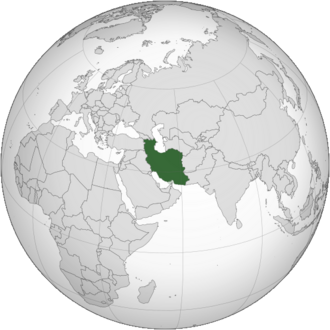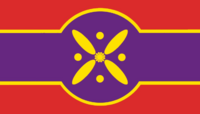Iran (Geopolity): Difference between revisions
No edit summary |
No edit summary |
||
| Line 136: | Line 136: | ||
A representative democracy, Iran is a [[wikipedia:Unitary_state|unitary]] [[wikipedia:Parliamentary_system|parliamentary]] [[wikipedia:Constitutional_monarchy|constitutional monarchy]] with a relatively recent yet vibrant democratic tradition, the second-oldest democratic state in the Middle East after [[wikipedia:Israel|Israel]]. Major tenets of Iranian democracy includes generally moderate coalition governments and an active, turbulent political sphere - only one political party, the Royalists, have stayed in their original form since the shift to constitutionalism. | A representative democracy, Iran is a [[wikipedia:Unitary_state|unitary]] [[wikipedia:Parliamentary_system|parliamentary]] [[wikipedia:Constitutional_monarchy|constitutional monarchy]] with a relatively recent yet vibrant democratic tradition, the second-oldest democratic state in the Middle East after [[wikipedia:Israel|Israel]]. Major tenets of Iranian democracy includes generally moderate coalition governments and an active, turbulent political sphere - only one political party, the Royalists, have stayed in their original form since the shift to constitutionalism. | ||
The authority of the state is vested nominally in the Shahanshah, with the Shahanshah officially [[wikipedia:Delegation|delegating]] all legislative, executive, and judicial responsibility to the Central Government. | The authority of the state is vested nominally in the Shahanshah, with the Shahanshah officially [[wikipedia:Delegation|delegating]] all legislative, executive, and judicial responsibility to the Central Government. The political system of Iran is mainly derived from the | ||
=== Imperial Diet === | === Imperial Diet === | ||
The [[wikipedia:Legislature|legislative branch]] of the Central Government is composed of the [[wikipedia:Bicameralism|bicameral]] Imperial Diet (Farsi: 𐬐𐬀𐬥𐬆𐬡𐬥𐬆𐬔𐬎𐬛𐬀𐬭 𐬱𐬀𐬵𐬀𐬥𐬱𐬀𐬵𐬀), composed of a [[wikipedia:Lower_house|lower house]], the Mehestan, and an [[wikipedia:Upper_house|upper house]], the Darbar. The Mehestan is composed of 800 [[wikipedia:Member_of_parliament|Members of the Mehestan]] (MMs), and are elected for 4-year terms via a system of [[wikipedia:Open_list|open-party list proportional representation]] in 144 five-seat constituencies with 80 leveling seats. | The [[wikipedia:Legislature|legislative branch]] of the Central Government is composed of the [[wikipedia:Bicameralism|bicameral]] Imperial Diet (Farsi: 𐬐𐬀𐬥𐬆𐬡𐬥𐬆𐬔𐬎𐬛𐬀𐬭 𐬱𐬀𐬵𐬀𐬥𐬱𐬀𐬵𐬀), composed of a [[wikipedia:Lower_house|lower house]], the Mehestan, and an [[wikipedia:Upper_house|upper house]], the Darbar. The Mehestan is composed of 800 [[wikipedia:Member_of_parliament|Members of the Mehestan]] (MMs), and are elected for 4-year terms via a system of [[wikipedia:Open_list|open-party list proportional representation]] in 144 five-seat constituencies with 80 leveling seats to make the Mehestan composition more proportional. | ||
=== Council of State === | === Council of State === | ||
Revision as of 17:04, 26 April 2024
Note that this Iran is not the same as the Islamic Republic of Iran. This page is a factbook for the Geopolity RP server. Please do not edit this page.
Empire of Iran 𐬆𐬭𐬀𐬥𐬱𐬀𐬵𐬭 (Farsi) Eranšahr | |
|---|---|
| Motto: "𐬀𐬥𐬛𐬀𐬱 𐬥𐬀𐬐𐬆, 𐬔𐬎𐬟𐬙𐬀𐬭 𐬥𐬀𐬐𐬆, 𐬐𐬆𐬭𐬛𐬀𐬭 𐬥𐬀𐬐𐬆" (Farsi) (Andaš Nake, Guftar Nake, Kerdar Nake) "Good Thoughts, Good Words, Good Deeds" | |
| Anthem: Long Live our Shahanshah | |
 Iran on the globe | |
| Capital and largest city | Rhages |
| Official languages | Farsi in the Avestan alphabet |
| Recognized national languages | Avestan (Liturgical) |
| Recognized regional languages | Azeri, Kurdish, Luri, Gilaki, Mazanderani, Armenian, Turkmen, Arabic, Balochi, Pashto, Tajik, Qashqai, Laki, Suret, Khorasani Turkic, Tati, Talysh |
| Ethnic groups | |
| Religion |
|
| Demonym(s) | Iranian |
| Government | Unitary Parliamentary Constitutional Monarchy |
• Shahanshah | His Majesty Ardashir VI |
• Shahbanu | Her Majesty Shirin III |
• Crown Prince | His Highness Behram |
• Wuzurg Framadar | The Honorable Ms. Behdis Gaanjia |
• Leader of the Opposition | The Honorable Mrs. Roya Mithawala |
• Speaker of the Mehestan | The Honorable Mr. Armun Moogana |
• Chancellor of the Darbar | His/Her Excellency Ms. Donya Zahedi |
• Chief Dadwar of the High Court | The Honorable Mr. Sasan Kadodwala |
| Legislature | The Imperial Diet |
| The Darbar | |
| The Mehestan | |
| Establishment History | |
| Area | |
• Total | 1,764,538 km2 (681,292 sq mi) |
• Water (%) | 1.1% |
| Population | |
• 2024 estimate | 105,400,000 |
• 2020 census | 103,674,582 |
• Density | 59.7/km2 (154.6/sq mi) |
| GDP (PPP) | 2024 estimate |
• Total | $2.73 trillion |
• Per capita | $25,888 |
| GDP (nominal) | 2024 estimate |
• Total | $852.7 billion |
• Per capita | $8,090 |
| Gini | 33.7 medium |
| HDI | 0.881 very high |
| Currency | Iranian Drachm (Ð) |
| Time zone | UTC+3:30 (IRST) [No DST] |
| Date format | dd-mm-yyyy (Z.E.R. and CE) |
| Driving side | right |
| Calling code | +98 |
| ISO 3166 code | IR |
| Internet TLD | .ir |
Iran, historically known as Persia by Western nations, and officially the Empire of Iran, is a country in West Asia. It is bordered by the Ottoman Empire to the west, Russia to the northwest, the Central Asian Union to the northeast, the Caspian Sea to the north, and the Iranian Gulf to the south, near Arabia. With over 100 million people in an area of 1.76 million sq km (about 680 thousand sq mi), Iran ranks as the 3rd largest nation in the Middle East by both population (behind Egypt and the Ottoman Empire) and largest by area (behind Egypt and Arabia). The nation's capital and most populous city is Rhages, with around 8 million people. Other major cities include Sanabad, Spahan, Baku, Tawres, Fars, Huzaye, Kom, and Hormuz.
Iran is one of the world's oldest civilizations, beginning with the Elamites in the fourth millennium BC. It was first unified by the Medes in the seventh century BC and reached its territorial height in the sixth century BC, when Cyrus the Great founded the Achaemenid Empire, one of the largest empires in antiquity. Alexander the Great conquered the empire in the fourth century BC, and it was subsequently divided into several Hellenistic states. An Iranian rebellion established the Parthian Empire in the third century BC, which was succeeded in the third century AD by the Sasanian Empire. After resistance to Arab Muslim attempts at a conquest of Iran, culminating in the victorious Battle of Nahavand, the Sasanians ruled the country until the Seljuk and the Mongol conquests of the 11th to 14th centuries. In the 15th century, the native House of Sasan re-established a neo-Sasanian Iran with Zoroastrianism as the official religion, marking the beginning of modern Iranian history.
Under Khosraw XI in the 18th century, Iran was a leading world power, though by the 19th century, it had lost significant influence through a series of conflicts with the Russian Empire. Under the liberal-minded Shahanshahs Peroz VIII and his son Vistahm V, the early and mid-20th century saw a significant shift towards fusing Western ideals such as the abolition of the traditional wuzurgan nobility and powers of the priestly elite, with traditional ideals such as the continued maintenance of Zoroastrianism as the state religion. In 1953, a series of popular protests throughout major cities in support of greater freedoms, combined with the recent election in support of the liberal, center-left Democratic Struggle Party and coalition into power, resulted in the adoption of a new constitution that greatly reduced the powers of the Shahanshah, while greatly expanding the powers of the Imperial Diet and the newly-created High Court in lieu of the mobeds as the judicial branch of the Central Government. The Iranian government is considered one of the most free and fair in the Middle East with its strong democratic traditions following the adoption of the new 1953 Constitution.
Iran is a major emerging, middle and regional power, due to its large reserves of fossil fuels, including the world's largest natural gas supply, third largest proven oil reserves, its large, technologically advanced industrial and financial capability, its business-friendly and entrepreneurial environment, its strategic location in the Asian continent, its military capabilities, its regional influence, and its role as the world's focal point of Zoroastrianism. It is a founding member of the United Assembly of Nations and an observer of the Global Security Association. Owing it to its long history and rich cultural legacy, Iran is home to many hundreds of national treasures, such as the ruins of Persepolis, Golestan Palace, and Falak-ol-Aflak, among other treasured sites. The people of Iran are multicultural and comprise a wide variety of ethnic, linguistic, and religious groups.
Etymology
The term Iran ("the land of the Aryans") derives from Middle Farsi Eran, first attested in a third-century inscription at Naqsh-e Rostam, with the accompanying Parthian inscription using Aryan, in reference to the Iranians. The terms Eran and Aryan are oblique plural forms of gentilic nouns er- (Middle Farsi) and ary- (Parthian), both deriving from Proto-Iranian language *arya- (meaning "Aryan", i.e. "of the Iranians"), recognised as a derivative of Proto-Indo-European language *ar-yo-, meaning "one who assembles (skilfully)". According to Iranian mythology, the name comes from Iraj, a legendary king.
Historically, Iran has been referred to as "Persia" by the West, due mainly to the writings of Greek historians who referred to all of Iran as "Persis" (Ancient Greek: Περσiς), meaning "the land of the Persians". "Persia" is the Farsa shahr in southwest Iran, also known as "Pars". The Farsi word "Fars" (𐬟𐬀𐬭𐬯), derived from the earlier form "Pars" (𐬞𐬀𐬭𐬯), which is in turn derived from Parsa (Old Farsi: 𐎱𐎠𐎼𐎿). Due to the province's historical importance, the term "Persia" originated from this region by the Greeks in around 550 BC, and Westerners started to refer the entire country as "Persia," until 1935, when Peroz VIII requested the international community to refer to the country by its native and original name, Iran. While the Iranians had been calling their nation Iran since at least 1000 BC, this name change was only made so that the Western World would begin to refer to the country by the same name as its people. Today, both Iran and Persia are used in cultural contexts, while Iran remains mandatory in official state and educational contexts.
History
Prehistory
EEE
Ancient Iran
EEE
Medieval Iran
EEE
Early modern period
EEE
Modern Iran
EEE
Geography
EEE
Islands and the dispute
EEE
Climate
EEE
Flora and fauna
EEE
Administrative divisions
EEE
Government and politics
A representative democracy, Iran is a unitary parliamentary constitutional monarchy with a relatively recent yet vibrant democratic tradition, the second-oldest democratic state in the Middle East after Israel. Major tenets of Iranian democracy includes generally moderate coalition governments and an active, turbulent political sphere - only one political party, the Royalists, have stayed in their original form since the shift to constitutionalism.
The authority of the state is vested nominally in the Shahanshah, with the Shahanshah officially delegating all legislative, executive, and judicial responsibility to the Central Government. The political system of Iran is mainly derived from the
Imperial Diet
The legislative branch of the Central Government is composed of the bicameral Imperial Diet (Farsi: 𐬐𐬀𐬥𐬆𐬡𐬥𐬆𐬔𐬎𐬛𐬀𐬭 𐬱𐬀𐬵𐬀𐬥𐬱𐬀𐬵𐬀), composed of a lower house, the Mehestan, and an upper house, the Darbar. The Mehestan is composed of 800 Members of the Mehestan (MMs), and are elected for 4-year terms via a system of open-party list proportional representation in 144 five-seat constituencies with 80 leveling seats to make the Mehestan composition more proportional.
Council of State
EEE
High Court
EEE
Provincial and Local Government
EEE
Political Parties
EEE
Law
EEE
Foreign Relations
EEE
Military
EEE
Regional Influence
EEE
Human Rights
EEE

